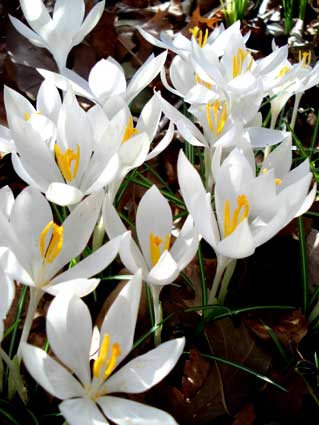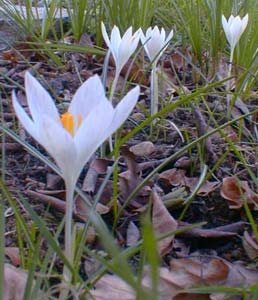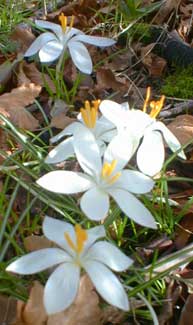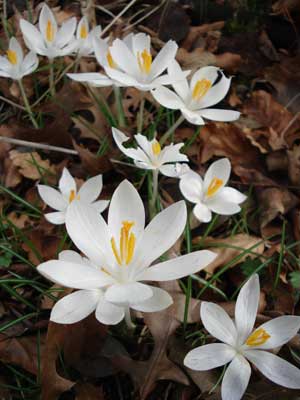
White
Tommies
"Winter never broke us
Spring has early woke us
Crocus blooms upon the grass
Delight for every lad & lass."
-j.a.s.,
winter's end 2005
winter's end 2005
 Crocus tommasinianus frequently has its name mispelled with only one "m," but it is easy to remember it has two if one thinks of the spelling of their common pet-name "tommies."
Crocus tommasinianus frequently has its name mispelled with only one "m," but it is easy to remember it has two if one thinks of the spelling of their common pet-name "tommies."White Tommies (C. tommasinianus var albus) were discovered as seedlings in the Oxford Botanical Garden. They are small two-inch flowers three inches tall, with wide-open pure white petals revealing bright yellow anthers.
They generally bloom in February, but in 2006 they began blooming mid-January, after a warmish winter of unusually heavy rainfall. They had one good sunny day that January but for most of those two weeks the sky was continuously overcast & the white tommies stood there like snake-heads peering up, & only began to show themselves fully open when the sun was better in February.
 They lasted a good full four weeks that year. The February 13th photo third on this page shows them in their fourth week still bright & not too badly knocked askew despite many days of rains.
They lasted a good full four weeks that year. The February 13th photo third on this page shows them in their fourth week still bright & not too badly knocked askew despite many days of rains.The following year, in 2007, they again bloomed in February (very bottom photo), but in 2008 (topmost photo) they waited until until May! Though they're in a rather shady spot between a shrub & a tree, they have many fully opened days & remain closed only when it is heavily overcast.
 For reasons I can't fathom, they are not often offered by bulb companies. The handful of purple cultivars offered all look pretty similar in shades of lilac to deep violet, so I'd think there'd be every reason to cultivate more of the strikingly different white form, which like other tommies naturalizes & spreads with ease.
For reasons I can't fathom, they are not often offered by bulb companies. The handful of purple cultivars offered all look pretty similar in shades of lilac to deep violet, so I'd think there'd be every reason to cultivate more of the strikingly different white form, which like other tommies naturalizes & spreads with ease.Their relative rarity makes them pricier, so Granny Artemis had to splurge in order to afford a mere ten corms to get started with. That was a few years ago & they have by now developed into quite a patch of blooms.
They have become one of my favorite crocuses because not merely beautiful (as are all crocuses) but they're less easily smashed by rainfall & can give a good showing even when sun isn't bright.
They were not as robust their first year as they were their second, & they were even more robust with each passing year. It's possible they are pricy bulbs because they are slower to establish & reproduce, though it seems to me they've developed quite apace of many other naturalizing species.
Perhaps someday they'll reach the mass-production stage & price will then be no higher than for other tommies, then more folks can afford more of them. I'd love to extend the drift over a much larger area, but if they remain expensive I'll be satisfied with the nicely thickening drift we have.
I planted them near the foot of an Oakleaf Beech, which being deciduous permits dappled sun to the crocuses during their late-winter season. They are planted near a drift of C. korolkowii 'Mountain's Glory' which bloom even earlier, starting mid to late January usually, though those bloomed even earlier than usual one year (in December in 2005 during that warmish very wet season).